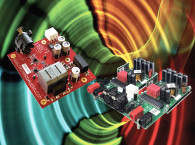As audioXpress reported in multiple articles, including one detailing an AES presentation by Bruno Putzeys and Lars Risbo where they offered a technical update on their plans (Purifi Audio - A Straight Wire to the Soul of Music), hysteresis distortion is at the core of the company's research since it happens in any coil that has a magnetic core, like the iron yoke in a speaker driver, inside the voice coil, in cored inductors in crossover filters, or the ferrite inductor in a class D amplifier. As Bruno Putzeys explains, "The cause is the ferromagnetic material that’s added to inductors to bring inductance up to usable levels."
Putzeys’ research of this phenomena was motivated by sporadic reports of a sort of 'granularity' in the sound reproduction with class D amplifiers. This prompted his investigation into whether this indeed happens, and if so, what would be the cause. After a long and winding road, Bruno finally found the culprit: hysteresis in the ferro-magnetic material of the amplifier output filter inductor.

The figure above highlights the issue. We all know the familiar B-H curve of ferro-magnetic materials. We tacitly assume that the signal traverses the B-H curve in each direction as given in the graph. What was found though was that the flux (and thus the voltage) at a specific point on the curve can be different depending how you arrive at that point. For instance, following the path 5 to 7 takes you through point 6, and although points 5 and 7 are identical on the B-H curve, the voltage at that point is not. The same situation occurs when you go from 2 to 4 through 3; the voltage values at identical points 2 and 4 are different depending on the path you took to arrive there. Clearly, there are voltage ‘jumps’ when, after traversing a minor B-H loop, you arrive at the same point at the major loop where you were before. So, there is an element of hysteresis - memory if you like - which causes strong non-linearity.
I believe this is a novel discovery, and even after reading it several times, I found it hard to get my head around it. Bruno tells me he had many inquiries for clarification and decided to write a white paper to explain the effect in more detail. And, that does indeed clarify it much better, particularly because it contains several animations that show the dynamic evolution of the current and voltage values while traversing the B-H curve.
You can read it at here and the document is highly recommended if you are in any way interested in inductors and transformers for analog applications.
www.purifi-audio.com








